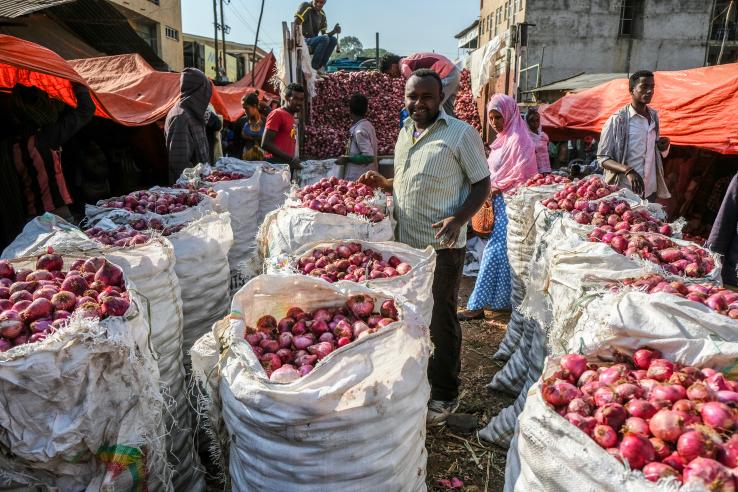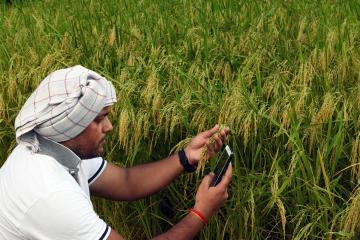
Building systems to improve and reward higher-quality agricultural products

Despite making investments in quality-enhancing technologies and practices, smallholder farmers in low- and middle-income countries do not always receive higher prices for their higher-quality agricultural goods. Our new Policy Insight reviews strategies designed to improve the quality of agricultural goods produced and sold at market.
Covid-19 lockdowns have presented a major challenge for the local and global markets in which most agricultural commodities are transacted in low- and middle-income countries. However, limitations to market access, commercialization, and certification systems for farmers in sub-Saharan Africa were a challenge before the world locked down in March 2020. Prior to the Covid-19 pandemic, many smallholder farmers in low- and middle-income countries were unable to take advantage of the stability and room for innovation afforded by access to consistent demand from local or international consumers.
One primary constraint is that current market structures are not often set up to reward farmers for producing higher-quality food that meets consumers’ changing quality standards—as incomes rise around the world, consumers prefer and become willing to pay for high-quality food. Research from J-PAL affiliated professors highlights an underlying set of issues that will become central again as these local and global markets begin to operate in the aftermath of full Covid-19 lockdowns.
Despite this shift in consumer preferences, many agricultural markets in low- and middle-income countries are still typically made up of disorganized supply chains with many intermediaries, who liaise between consumers and producers and have little incentive to reward high-quality agricultural products with higher prices. If consumers want high-quality food and if farmers are capable of producing high-quality products, then the absence of these incentives can have negative consequences on both consumer welfare and farmer income.
New insights on technologies and practices to improve the quality of food
The Agricultural Technology Adoption Initiative (ATAI) is a joint research initiative with the Center for Effective Global Action and funded by the Bill & Melinda Gates Foundation and the UK Foreign, Commonwealth, & Development Office. Since 2009, ATAI-funded research in sub-Saharan Africa and South Asia has shown that despite the promise of agricultural technology to boost productivity and transform agricultural livelihoods, adoption of technology is low, suggesting that there are other barriers constraining farmers’ decision to adopt. As such, ATAI saw there was an opportunity to rethink agricultural development. In 2019, ATAI pivoted to support research to answer critical questions related to raising farmers out of poverty and supporting them as they move along the agricultural transformation spectrum towards commercialization.
Among others, this includes testing interventions that support farmers to produce higher-quality goods to secure market access and market share and, subsequently, increase their incomes. Doing so requires that policies and programs identify where in the value chain quality is assessed, where in the production cycle quality can be most efficiently improved, and who has the incentive to make adjustments and ensure that the benefits reach farmers.
From foodstuffs, like wheat and onions, to cash crops, like coffee and cacao, researchers have been working to understand which programs help farmers overcome constraints to improve the quality of their outputs. In a new Policy Insight, we look at seven studies—four of which received funding from ATAI—that assessed interventions that targeted farmers directly with inputs or access to markets, provided information to farmers on the quality of their service providers, or worked with traders and middlemen to provide price incentives for higher-quality crops purchased from smallholder farmers.
This body of research shows that the fundamentals for quality improvement are in place: consumers (both rural and urban) are willing to pay for quality, and farmers are able to produce quality when given the right incentives. However, while this research shows that improving the quality of agricultural goods can improve both farmers’ profits and consumers’ welfare, real challenges exist in creating quality certification mechanisms that can successfully sustain these gains over time. The focus should, thus, switch to the exploration of policies that can sustainably build, formalize, and scale market-level quality grading and certification systems to support long-term gains.
As countries slowly reopen and vaccines are distributed, this is a prime opportunity to make market-level changes to agricultural systems and policies to ensure that higher-quality goods are produced to meet consumer demand and that prices reflect the quality of those goods.
Related Content

Why aren’t farmers using improved agricultural technologies to increase their profits? Lessons from ten years of research in the Agricultural Technology Adoption Initiative

Affiliate Spotlight: Shawn Cole

